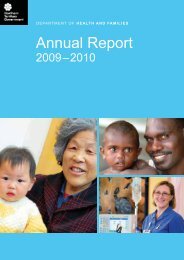PCD Strategy Evaluation 2007.pdf - NT Health Digital Library ...
PCD Strategy Evaluation 2007.pdf - NT Health Digital Library ...
PCD Strategy Evaluation 2007.pdf - NT Health Digital Library ...
Create successful ePaper yourself
Turn your PDF publications into a flip-book with our unique Google optimized e-Paper software.
CHAPTER 5. KEY RESULT AREASThis chapter reports on the progress being made towards meeting the <strong>NT</strong><strong>PCD</strong>S ten-year goal –to reduce the projected incidence and prevalence of the five common chronic diseases in the <strong>NT</strong>and their immediate underlying causes (13) . The key result areas are:5.1 Maternal healthThe <strong>Health</strong> and Well Being of Northern Territory Women: from the Desert to the Sea waspublished in November 2005. Apart from data on child protection reports and children in care,the report highlights that women represent 67% of all victims of manslaughter, 60% of victims ofassault and 95% of sexual assault victims. The report also highlights the barriers to reporting,particularly for Aboriginal women.5.1.1 Improving infant birthweightOne major program developed in the <strong>NT</strong> to address low birth weight in Indigenous communitieswas the Strong Women, Strong Babies, Strong Culture Program (SWSBSC). The aim of theSWSBSC was for senior women within Aboriginal communities to help younger Aboriginal women:‣ prepare for pregnancy‣ to support pregnant Aboriginal women by encouraging them to visit clinics for antenatalcare early in their pregnancy‣ by providing advice and encouragement about healthy pregnancy management inrelation to nutrition (including greater use of bush foods)‣ by promoting the adoption of safe practices such as not taking alcohol and smokingduring pregnancy, and‣ by reinforcing the need to seek adequate and timely medical help and to take prescribedmedicines (90) .The program began in 1993 as a pilot project in three Top End communities of the NorthernTerritory that were interested in participating and that had poor peri-natal health. Between late1996 and early 1997, it was implemented in a second group of communities that also had poorperi-natal health status. In 2003, the program was reviewed and concluded that, although theprogram had shown significant results in the communities in which it was first trailed, it had littleeffect when the other communities were included (90, 91) .Chapter 5: Key Result Areas – <strong>Evaluation</strong> of the <strong>NT</strong> Preventable Chronic Disease <strong>Strategy</strong> 2007 78
















